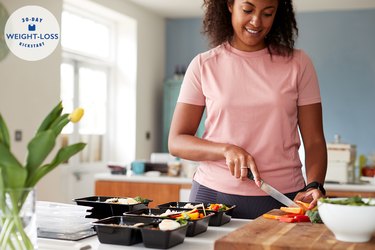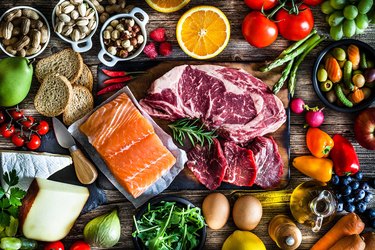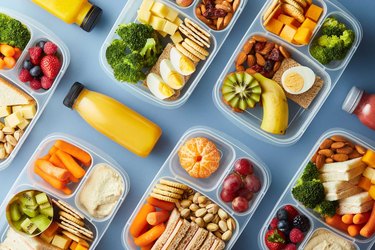
If you're trying to lose weight, you've likely been told to "watch your portions!" by at least one well-meaning soul. This isn't bad advice, actually — as long as you know what the heck it means.
Here's a hint: Your diet-whisperer is likely talking about portion control, a practical approach to eating that puts the focus on food portion sizes (which are different from serving sizes — more on that later). The idea is that no foods are completely off-limits, but everything can and should be eaten in moderation.
Sounds pretty simple, right? But there are a few things you should know before you dive in. Here, we've put together everything you need to know about starting a portion-control diet, from the science-backed benefits to the tools and tricks dietitians swear by.
Ready to Lose Weight?
Set yourself up for success with more from our 30-Day Weight-Loss Kickstart.
What Is Portion Control, Anyway?
Portion control is a practical way of eating that can help you lose weight or simply eat healthier. Instead of counting calories or avoiding certain macronutrients altogether, this method puts the focus on learning what a healthy portion size of each food looks like — and sticking to it.
So, where to start? The U.S. Department of Agriculture (USDA) is the go-to source when it comes to how much of each food group (vegetables, fruit, grains, dairy, protein and oils) you should be eating on the daily. While the USDA doesn't set rigid rules on portion sizes, it does offer general guidelines that you can adapt for your specific goals.
According to the 2015-2020 Dietary Guidelines for Americans, which were created by the USDA and the U.S. Department of Health and Human Services, a healthy and balanced diet for an adult who needs 2,000 daily calories might include the following amounts from each food group:
- Vegetables: 2 1/2 cups
- Fruit: 2 cups
- Grains: 6 ounces
- Dairy: 3 cups
- Protein: 5 1/2 ounces
- Oils: 27 grams

What’s So Great About Portion Control?
Practicing portion control helps you get the nutrients you need without restricting or overindulging — the latter of which is easy to do these days, when serving sizes at most restaurants far exceed the recommended calories you should be getting in one sitting, according to an April 2016 study in the Journal of the Academy of Nutrition and Dietetics.
Think about it this way: When you're out at a restaurant and the waiter brings you a huge plate filled with food, two things are likely to happen:
- You'll consume more than you intended. Research consistently shows that people eat more when presented with larger portions, according to a review of 72 studies published September 2015 in The Cochrane Database of Systematic Reviews.
- You'll think you ate less than you actually did. A study published in BMJ in May 2013 found that adults underestimated the calorie content of meals at fast food restaurants by more than 20 percent, and that number climbed even higher for larger meals and those labeled as "healthy."
Controlling your portions helps you more accurately determine how much food you're taking in at each meal, which not only helps with weight loss but can also positively affect other areas of your health.
Learn about four benefits you're likely to reap when you practice portion control. ** **
Tip
Download LIVESTRONG.com’s free calorie-tracking app MyPlate. Once you’ve portioned out your breakfast, lunch, dinner or snack, entering it into the app will help make sure you’re staying on target for the day’s calories, carbs, protein and fat.
What Healthy Food Portions Really Look Like
Knowing you need 2 1/2 cups of veggies, 2 cups of fruit and 5 1/2 ounces of protein a day is one thing. But can you tell when you've served yourself a healthy portion of, say, asparagus? Should the size of your morning grapefruit rival your breakfast plate or your coffee mug? And just how big is a 3-ounce serving of salmon, really?
See what serving sizes of meat, poultry, fish and seafood actually look like, compared to everyday objects, so you can easily calculate just how much you're getting.
Tricks to Make Portion Control Easier
When you're just starting out, the trickiest part of portion control might be recognizing the difference between a portion size and a serving size.
In a nutshell: The serving size of a food refers to a measurement on a nutrition label, while portion size is what you actually eat in a sitting. The two are often different, and portion sizes can be much smaller than serving sizes for those who are trying to lose weight, says Emily O'Neil, RDN, LDN, a weight-loss coach at the Austin Diagnostic Clinic in Austin, Texas.
Even when you understand this key difference, it can still be tough to cut back on portions when you're used to seeing a lot more food on your plate. Luckily, we've got a few tricks that can help.
*Check out eight dietitian-approved hacks to simplify portion control. (Spoiler: You're probably using the wrong spoon). *

The Tools You Need to Succeed
There are also some tools that can help when it comes to planning your meals and sticking to the healthiest amounts of each food.
Portion control plates, for example, give you a visual reminder of the USDA guidelines when it comes to food group portions, helping to take the guesswork out of measuring your meals.
Portion control containers — glass or plastic containers that are sized to help you measure and regulate the amount of food you eat at each meal — are also a user-friendly option and especially good for those who want to prep their meals ahead of time. Ready to give them a try?
*Here's your guide to the best portion control containers based on your personal needs. *